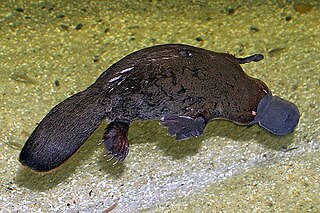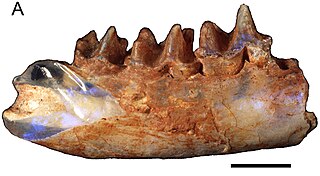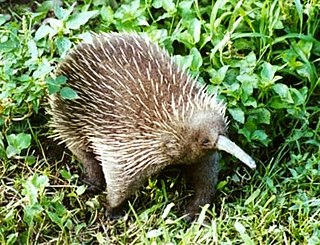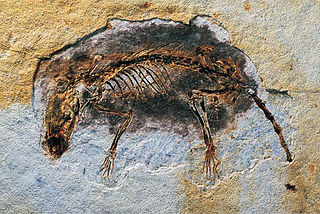
The Ornithorhynchidae are one of the two extant families in the order Monotremata, and contain the platypus and its extinct relatives. The other family is the Tachyglossidae, or echidnas.

Prototheria is an obsolete subclass of mammals which includes the living Monotremata and to which a variety of extinct groups, including Morganucodonta, Docodonta, Triconodonta and Multituberculata, have also been assigned. It is today no longer considered a valid grouping, but rather a paraphyletic evolutionary grade of basal mammals and mammaliaform cynodonts.

Kollikodon is an extinct species of mammal, considered to be an early monotreme. It is known only from an opalised dentary fragment, with one premolar and two molars in situ, as well as a referred maxillary fragment containing the last premolar and all four molars. The fossils were found in the Griman Creek Formation at Lightning Ridge, New South Wales, Australia. Kollikodon lived in the Late Cretaceous period, during the Cenomanian age. Several other monotremes are known from the Griman Creek Formation, including Dharragarra, Opalios, Parvopalus, Steropodon, and Stirtodon.

Steropodon is a genus of prehistoric platypus-like monotreme, or egg-laying mammal. It contains a single species, Steropodon galmani, that lived about 100.2–96.6 million years ago during the Cretaceous period, from early to middle Cenomanian. It is one of the oldest monotremes discovered, and is one of the oldest Australian mammal discoveries. Several other monotremes are known from the Griman Creek Formation, including Dharragarra, Kollikodon, Opalios, Parvopalus, and Stirtodon.
Teinolophos is a prehistoric species of monotreme, or egg-laying mammal, from the Teinolophidae. It is known from four specimens, each consisting of a partial lower jawbone collected from the Wonthaggi Formation at Flat Rocks, Victoria, Australia. It lived during the late Barremian age of the Lower Cretaceous.

The long-beaked echidnas make up one of the two extant genera of echidnas: there are three extant species, all living in New Guinea. They are medium-sized, solitary mammals covered with coarse hair and spines made of keratin. They have short, strong limbs with large claws, and are powerful diggers. They forage in leaf litter on the forest floor, eating earthworms and insects.

Tribosphenida is a group (infralegion) of mammals that includes the ancestor of Hypomylos, Aegialodontia and Theria. It belongs to the group Zatheria. The current definition of Tribosphenida is more or less synonymous with Boreosphenida.

The Australosphenida are a clade of mammals, containing mammals with tribosphenic molars, known from the Jurassic to Mid-Cretaceous of Gondwana. Although they have often been suggested to have acquired tribosphenic molars independently from those of Tribosphenida, this has been disputed. Fossils of australosphenidans have been found from the Jurassic of Madagascar and Argentina, and Cretaceous of Australia and Argentina. Monotremes have also been considered a part of this group in many studies, but this is also disputed.

Megalibgwilia is a genus of echidna known only from Australian fossils that incorporates the oldest-known echidna species. The genus ranged from the Miocene until the late Pleistocene, becoming extinct about 50,000 years ago. Megalibgwilia species were more widespread in warmer and moist climates. Their extinction can be attributed to increasing aridification in Southern Australia.
The Griman Creek Formation is a geological formation in northern New South Wales and southern Queensland, Australia whose strata date back to the Albian-Cenomanian stages of the mid-Cretaceous. It is most notable being a major source of opal, found near the town of Lightning Ridge, New South Wales. Alongside the opal opalised fossils are also found, including those of dinosaurs and primitive monotremes.

Murrayglossus is an extinct echidna from the Pleistocene of Western Australia. It contains a single species, Murrayglossus hacketti, also called Hackett's giant echidna. Though only from a few bones, researchers suggest that Murrayglossus was the largest monotreme to have ever lived, measuring around 1 metre (3.3 ft) long and weighing around 20–30 kilograms (44–66 lb). Historically treated as a species of long-beaked echidnas, it was separated into its own genus Murrayglossus in 2022. The generic name combines the last name of paleontologist Peter Murray and glossus, the Greek word for "tongue".

Monotremes are mammals of the order Monotremata. They are the only known group of living mammals that lay eggs, rather than bearing live young. The extant monotreme species are the platypus and the four species of echidnas. Monotremes are typified by structural differences in their brains, jaws, digestive tract, reproductive tract, and other body parts, compared to the more common mammalian types. Although they are different from almost all mammals in that they lay eggs, like all mammals, the female monotremes nurse their young with milk.

Yinotheria is a proposed basal subclass clade of crown mammals uniting the Shuotheriidae, an extinct group of mammals from the Jurassic of Eurasia, with Australosphenida, a group of mammals known from the Jurassic to Cretaceous of Gondwana, which possibly include living monotremes. Today, there are only five surviving species of monotremes which live in Australia and New Guinea, consisting of the platypus and four species of echidna. Fossils of yinotheres have been found in Britain, China, Russia, Madagascar and Argentina. Contrary to other known crown mammals, they retained postdentary bones as shown by the presence of a postdentary trough. The extant members (monotremes) developed the mammalian middle ear independently.
Teinolophidae is an extinct family of small, carnivorous mammals that were the earliest known monotremes and were endemic to what would become Australia. Two genera are known: Teinolophos, and possibly also Stirtodon.
Opalios is an extinct genus of monotreme mammal from the Late Cretaceous (Cenomanian) Griman Creek Formation of Australia. The genus contains a single species, O. splendens, known from a fragmentary left dentary.
Dharragarra is an extinct genus of monotreme mammal from the Late Cretaceous (Cenomanian) Griman Creek Formation of Australia. The genus contains a single species, D. aurora, known from a partial left mandibular ramus. Dharragarra was likely more closely related to the living platypus than many other monotremes of the Cretaceous.
Parvopalus is an extinct genus of monotreme mammal from the Late Cretaceous (Cenomanian) Griman Creek Formation of Australia. The genus contains a single species, P. clytiei, known from a partial left dentary.

Ornithorhynchoidea is a superfamily of mammals containing the only living monotremes, the platypus and the echidnas, as well as their closest fossil relatives, to the exclusion of more primitive fossil monotremes of uncertain affinity.
Sundrius is an extinct genus of probable monotreme mammal from the Late Cretaceous (Albian) Eumeralla Formation of Australia. The genus contains a single species, S. ziegleri, known from a broken molar.
Stirtodon is an extinct genus of monotreme mammal from the Late Cretaceous (Cenomanian) Griman Creek Formation of Australia. The genus contains a single species, S. elizabethae, known from a large isolated premolar. Stirtodon may be the largest toothed monotreme discovered. Several other monotremes are known from the Griman Creek Formation, including Dharragarra, Kollikodon, Opalios, Parvopalus, and Steropodon.
















